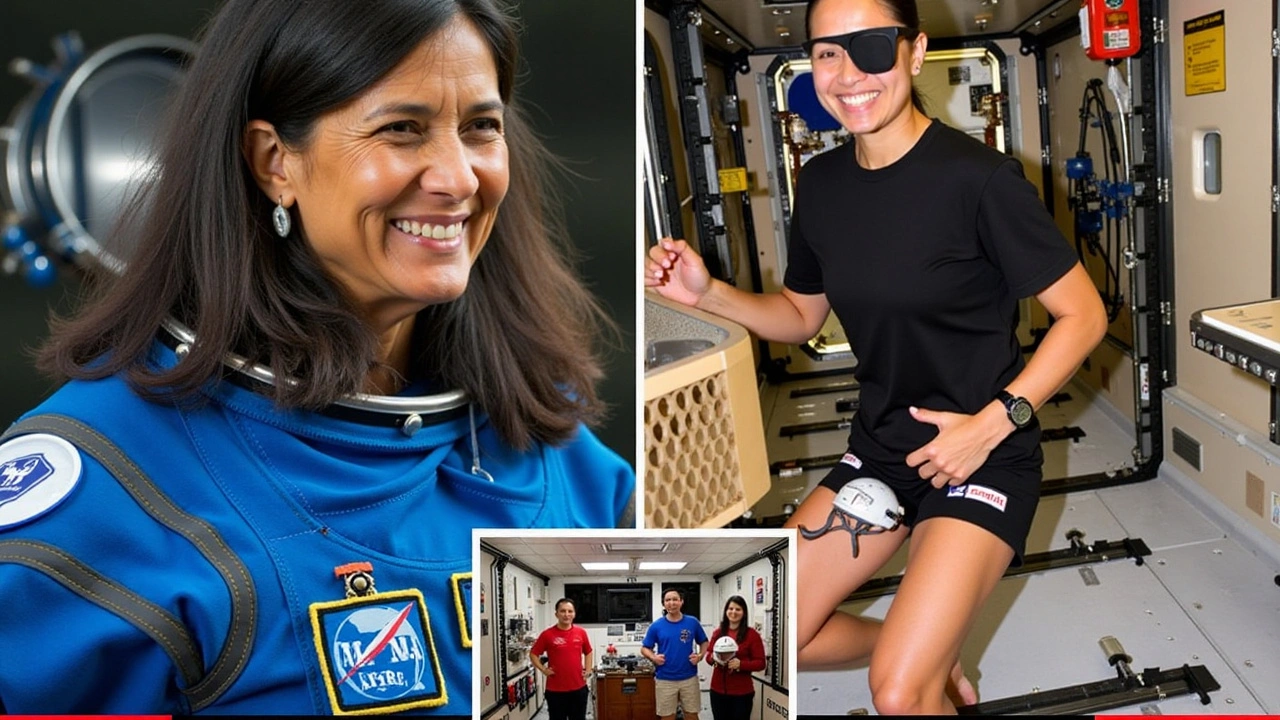NASA's Artemis Mission Lands Astronauts on the Moon
NASA's Artemis mission has made history by successfully landing astronauts on the Moon, heralding a new chapter in human space exploration. This monumental achievement has demonstrated not only the technological prowess of NASA but also the collaborative spirit of international partners who have contributed to this historic endeavor. The mission's success represents a crucial step toward long-term plans of establishing a sustainable human presence on the Moon and sets the stage for the eventual journey to Mars.
Launch from Kennedy Space Center
On a crisp morning at the Kennedy Space Center in Florida, the Artemis mission began its journey to the Moon. The spacecraft, named Orion, was perched atop NASA's new heavy-lift rocket, the Space Launch System (SLS), ready to embark on a journey of over 480,000 kilometers. As the countdown reached zero, the powerful engines roared to life, and the rocket ascended gracefully into the sky, leaving a trail of fire and smoke behind. This moment marked the beginning of a mission that would captivate the hearts and minds of people across the globe.
Journey to the Moon
Once in space, Orion's journey was far from over. The spacecraft had to navigate through the vast expanse of space, facing numerous challenges and relying on precision navigation to reach its lunar destination. The trip to the Moon took Orion past the threshold of Earth's gravitational influence and into the domain of the Moon's gravity. As Orion approached lunar orbit, the mission control team in Houston worked tirelessly to ensure every maneuver was executed flawlessly. The journey exemplified the meticulous planning and coordination required for deep space missions.
Lunar Orbit and Descent
With Orion successfully in lunar orbit, the next critical phase of the mission began. The lunar lander, aptly named Starship, was prepped for its descent to the Moon's surface. The separation of Starship from Orion was a tense moment, watched closely by NASA officials and space enthusiasts alike. As the lander descended, it had to navigate the Moon's rugged terrain, guided by sophisticated navigation systems and the skilled hands of the astronauts onboard. The successful landing was met with cheers and jubilation, marking a triumphant moment for the Artemis mission.
Scientific Exploration on the Lunar Surface
The crew, comprised of a diverse team of astronauts, stepped onto the lunar surface, leaving their footprints on the Moon's dusty landscape. Their mission was not just a symbolic gesture but a scientifically rich endeavor. Over the course of several days, the astronauts conducted a series of experiments designed to expand our understanding of the Moon and its environment. They collected samples of lunar soil and rocks, which will provide invaluable insights into the history and composition of the Moon. These samples are expected to offer clues about the early solar system and inform future lunar missions.
Demonstrating New Technologies
The Artemis mission also served as a proving ground for new technologies and capabilities. The Space Launch System (SLS), NASA's latest heavy-lift rocket, showcased its ability to carry astronauts and cargo beyond Earth's orbit. The Orion spacecraft demonstrated its versatility and advanced systems designed to support crewed missions to deep space. The success of these technologies is pivotal for future missions, including potential manned missions to Mars. The mission underscored the importance of innovation and technological advancement in making human space exploration feasible and sustainable.
International Collaboration and Future Goals
The Artemis mission's success was not solely a triumph for NASA but also a testament to international collaboration. Partners from around the world contributed expertise, technology, and support to ensure the mission's success. This collective effort highlights the importance of global cooperation in pushing the boundaries of space exploration. The insights and data gathered from this mission will be shared with international partners, fostering a spirit of unity and mutual progress in the quest to explore the cosmos.
Looking Ahead: Manned Missions to Mars
As the Artemis astronauts prepare to return to Earth, they bring with them a wealth of knowledge and experience that will inform the planning of future missions. The success of the Artemis mission is a pivotal step towards more ambitious goals, including the eventual goal of sending humans to Mars. The journey to the Red Planet presents its own set of challenges, but the lessons learned from the Artemis mission will be instrumental in overcoming them. The data collected from the Moon will help scientists and engineers refine their strategies and technologies for sustained human exploration beyond Earth's orbit.
Celebration and Reflection
The successful completion of the Artemis mission has been met with widespread celebration and acclaim. NASA officials, international partners, and space enthusiasts worldwide have praised the dedication, teamwork, and ingenuity that made the mission possible. This achievement serves as a reminder of what humanity can accomplish when we work together towards a common goal. It also rekindles the spirit of exploration that has driven us to seek out new frontiers and expand our understanding of the universe.
Conclusion: A Giant Leap for Mankind
The Artemis mission's successful landing on the Moon marks a new era in space exploration. It represents a significant milestone in NASA's long-term strategy to expand human presence beyond Earth's orbit. The mission has demonstrated the capabilities of cutting-edge technologies and the importance of international collaboration in achieving ambitious goals. As we look to the future, the lessons learned from Artemis will pave the way for even greater achievements, including the eventual journey to Mars. The spirit of exploration that drove the Artemis mission continues to inspire and guide us as we reach for the stars.


Pauline Herrin
August 4, 2024 AT 21:19While the Artemis achievement is undeniably a milestone in the annals of aerospace engineering, it merits a measured critique beyond celebratory rhetoric. The mission's theatrical launch, though visually spectacular, underscores an overreliance on legacy propulsion techniques that have historically plagued cost efficiency. Moreover, the narrative of international collaboration, while commendable, often masks the disproportionate contribution of a single agency, thereby diluting the authenticity of the partnership claim. The scientific payloads, though numerous, appear to prioritize public relations objectives over substantive geological inquiry. It is also noteworthy that the lunar sample collection strategy repeats methodologies from prior missions without introducing novel analytical frameworks. The reliance on Orion’s existing life support systems, rather than developing next‑generation autonomous habitats, suggests a conservative approach that may impede long‑term sustainability. Furthermore, the mission’s public outreach, while extensive, frequently employs hyperbolic language that could mislead stakeholders regarding the immediacy of a Mars expedition. The allocation of budgetary resources toward high‑profile media events invites scrutiny when juxtaposed with underfunded deep‑space instrumentation programs. In addition, the decision to name the lander “Starship” creates brand confusion with private commercial endeavors, potentially obfuscating accountability. The terrestrial launch infrastructure, still dependent on outdated launch pads, raises concerns about operational resilience. The mission timeline, compressed to meet political milestones, may compromise thorough post‑flight analysis. The heavy‑lift SLS, though a technical marvel, suffers from an unsustainably high cost per kilogram, which could limit future payload diversity. The reliance on a singular crew module architecture restricts modular expansion for subsequent lunar bases. The data sharing protocols with international partners, while proclaimed, lack transparent enforcement mechanisms. Finally, the celebratory narrative must be tempered with a realistic assessment of the technical and fiscal challenges that lie ahead for sustained extraterrestrial habitation.
pradeep kumar
August 15, 2024 AT 10:14The mission’s hype outweighs its practical contributions.
love monster
August 25, 2024 AT 23:09From a systems‑engineering perspective, Artemis showcases an impressive integration of propulsion, guidance, and thermal‑control subsystems, all of which synergize to enable a reliable lunar descent trajectory. The utilization of high‑thrust engines during translunar injection exemplifies advanced thrust‑vector control, while the onboard avionics suite leverages redundant sensor arrays to maintain orbital stability. Additionally, the mission’s payload architecture reflects a modular design philosophy, allowing for incremental upgrades in future iterations without extensive re‑qualification. This kind of forward‑compatible engineering is essential for scalable lunar infrastructure development.
Christian Barthelt
September 5, 2024 AT 12:05Actually, the “modular design” claim ignores the fact that Orion’s internal layout remains rigid, limiting true scalability.
Ify Okocha
September 16, 2024 AT 01:00The article glosses over the fact that the SLS’s payload capacity is grossly overrated, leading to unnecessary budget inflation and a false sense of progress.
William Anderson
September 26, 2024 AT 13:56One must note the dramatic disparity between the mission’s promised scientific yield and the meager sample volume returned. While the narrative paints a picture of abundant lunar bounty, the actual curation efforts appear half‑hearted, bordering on pretentious minimalism. Moreover, the grammar in the press releases-"astronauts stepped onto" versus "astronauts step onto"-underscores a lack of editorial rigor. Such linguistic sloppiness mirrors the mission’s broader tendency toward superficial grandeur.
Sherri Gassaway
October 7, 2024 AT 02:51In contemplating humanity's venture beyond Earth, we confront the perennial question: does the ascent of metal and fire merely echo our ancient yearning, or does it manifest a deeper ontological shift toward collective transcendence? The lunar landing, therefore, becomes a symbolic altar upon which we inscribe both our hubris and our hope.
Milo Cado
October 17, 2024 AT 15:46Congratulations to everyone involved! This achievement truly embodies the spirit of collaboration and perseverance. It paves the way for future exploration, and I’m excited to see what’s next 🚀😊
MONA RAMIDI
October 28, 2024 AT 03:42The whole thing felt staged, a drama parade designed to distract from the real budget crises.
grace riehman
November 7, 2024 AT 16:37hey thers stuff i wanna say – the artemis thing is cool but i think we shud be more inclusive of all cultures n peoples in space, not jus the same old story.
Vinay Upadhyay
November 18, 2024 AT 05:33Oh great, another “giant leap” that conveniently ignores the sloppy grammar in the official briefings-"moon" instead of "the Moon"-as if the distinction even matters. Yet we’re supposed to marvel at the “precision” of a mission riddled with linguistic errors. Sarcasm aside, the data quality will ultimately speak louder than any PR spin.
Eve Alice Malik
November 28, 2024 AT 18:28I'm curious about the long‑term habitat plans. Will there be enough life‑support redundancy for extended stays, or are we just testing short‑term stays?
Debbie Billingsley
December 9, 2024 AT 07:23The United States has once again demonstrated its unrivaled leadership in space exploration, setting a benchmark that other nations should strive to emulate.
Patrick Van den Berghe
December 19, 2024 AT 20:19Congrats to the team the mission was a success